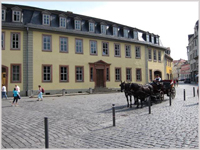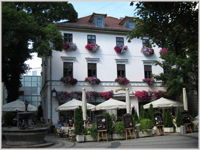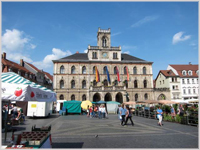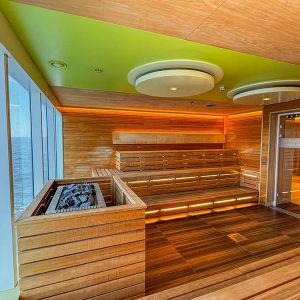 There can be few finer places in which to appreciate the European struggle between light and darkness than Weimar. The Anna Amalia library is an exquisite example of Enlightenment thinking. Buchenwald, the Nazi concentration camp, is just up the road.
There can be few finer places in which to appreciate the European struggle between light and darkness than Weimar. The Anna Amalia library is an exquisite example of Enlightenment thinking. Buchenwald, the Nazi concentration camp, is just up the road.
We follow its history in reverse. it would have been logical to begin in the age of Goethe and Schiller and progress to the madness of the early and mid 20th century but our route through this elegant, tidy town, where the horses which draw the tourist carriages are provided with what might be described loosely as nappies – to keep the cobblestones clean – takes us first past the Bauhaus museum.
Weimar was the cradle of the Bauhaus, a later version of William Morris's Arts and Crafts Movement in the way it embraced all the relevant disciplines. It was at its zenith in the early years of the last century under the Belgian Henry van der Velde and then Walter Gropius. Kandinsky and Klee came to teach. But there were danger signs even under the short lived republic founded in Weimar, well before Hitler crushed the avant garde.
It's a small museum – the recent Bauhaus exhibition at London's Barbican was much bigger – but it provides a neat precis of the influence the movement exerted on design to this day – from tea pots to furniture.
 We lunch quickly on yet another Thuringian sausage, bought from a stand on another Market Square, where Meissen porcelain bells, taken down and squirrelled away in a cave during the Second Word War for fear they might be shattered by bombs, mark the hours with thin chimes and head for the library. The rococo room there takes your breath away. If you see nothing else in Weimar, make sure you buy a timed ticket, pick up the audio guide and spend as much time there as you can.
We lunch quickly on yet another Thuringian sausage, bought from a stand on another Market Square, where Meissen porcelain bells, taken down and squirrelled away in a cave during the Second Word War for fear they might be shattered by bombs, mark the hours with thin chimes and head for the library. The rococo room there takes your breath away. If you see nothing else in Weimar, make sure you buy a timed ticket, pick up the audio guide and spend as much time there as you can.
Anna Amalia (I won't trouble you with her lineage) married Duke Ernst II Konstantin of Saxe-Weimar-Eisenach in her late teens. He popped his clogs two years later, leaving her with a long widowhood in which to fill her time. She founded the library in 1766, with the then revolutionary idea opening it not just to the upper classes but to all comers. Schiller borrowed history books, Goethe, of course, was interested in everything, from the philosophy of Descartes to Humboldt's account of his South American expedition. He made over 2000 loans. History doesn't record whether he suffered any fines for late returns.
In 2004 the library went up in smoke. A fire cause by an electrical fault destroyed around 50,000 volumes and damaged many others. Water from hoses poured into the tiered rococo room, which had to be painstakingly restored. The story of how experts worked to save soaked and charred books is riveting. Those left soggy by the water were put in freezers and slowly thawed later, to prevent mould.
 Ever read Goethe? It's hard work. I suspect he was a bit of an old hypocrite, since he lived with the humble Christiana Vulpius for years before marrying her while urging stern punishment for a single mum who killed her child. But you can't but admire him as the ultimate polymath. His former home contains a graceful old wooden staircase, his study, left much as it was, the chair in which he died – and a piano which Mendelssohn played. (Make a bit of noise, would you, young man?", Goethe asked him. The exhibition next door shows just how wide were his interests. There are showcases full of minerals, artworks, skeletons of small mammals and birds.
Ever read Goethe? It's hard work. I suspect he was a bit of an old hypocrite, since he lived with the humble Christiana Vulpius for years before marrying her while urging stern punishment for a single mum who killed her child. But you can't but admire him as the ultimate polymath. His former home contains a graceful old wooden staircase, his study, left much as it was, the chair in which he died – and a piano which Mendelssohn played. (Make a bit of noise, would you, young man?", Goethe asked him. The exhibition next door shows just how wide were his interests. There are showcases full of minerals, artworks, skeletons of small mammals and birds.
You can't get away from Goethe in Weimar. "I'm all Goethe'd out" says my wife, as a chilled pils beckons. We slake out thirsts and head back to the Hotel Elephant, where we are staying. The hotel, which, opened as an inn in 1696, has a guest list full of celebrity and notoriety – from Hans Christian Andersen to Adolf Hitler. Inevitably, there's a Goethe connection. In 1829 they celebrated his 80th birthday there.











